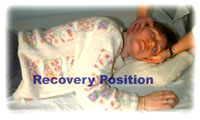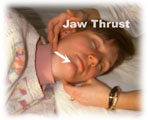First aids may be needed in a person experiencing a tonic-clonic seizure and to a
lesser extent complex partial seizure in which there is convulsion. However, in most
cases there is no convulsion little needs to be done so. Your reassurance and understanding
after the seizure are perhaps the best FIRST AID of all.
NOTE!
During a CONVULSIVE seizure
(fall to ground/ sudden outcry/ stiff & tense/ rapid breathing)
DONT's
![]() Do not try to stop or restrict the seizure/jerking
movements
by forcibly controlling the person's actions or try to get them to
'come to their senses’. This contraction is extremely powerful and can result
in broken bones if it is hindered.
Do not try to stop or restrict the seizure/jerking
movements
by forcibly controlling the person's actions or try to get them to
'come to their senses’. This contraction is extremely powerful and can result
in broken bones if it is hindered.
![]() Do not try to put anything into their mouths
as
anything including fingers might broke or resulted broken teeth. It is
medically impossible to swallow your tongue, so there is no need for such
action either.
Do not try to put anything into their mouths
as
anything including fingers might broke or resulted broken teeth. It is
medically impossible to swallow your tongue, so there is no need for such
action either.
![]() Do
not try to give any medications/fluids when a person remains non-interactive.
Anything by mouth should be given when a person starts talking.
Do
not try to give any medications/fluids when a person remains non-interactive.
Anything by mouth should be given when a person starts talking.
DO's
![]() Try noting down the behaviors during a seizure
and tell the person about them when they regain consciousness. This may help
especially if this is among the first seizures a person experience. Doctor needs
such information as detail as possible to make accurate diagnosis.
Try noting down the behaviors during a seizure
and tell the person about them when they regain consciousness. This may help
especially if this is among the first seizures a person experience. Doctor needs
such information as detail as possible to make accurate diagnosis.
![]() Stay with the
person and make sure that they
cannot harm themselves before regaining consciousness.
Stay with the
person and make sure that they
cannot harm themselves before regaining consciousness.
![]() Create the safest
possible environment by removing objects which may cause physical injury and
provides a soft surface if possible.
Create the safest
possible environment by removing objects which may cause physical injury and
provides a soft surface if possible.
![]() Leave the person alone until their muscles
relax. You may want to use your hands to cushion the head to prevent banging
against the floor.
Leave the person alone until their muscles
relax. You may want to use your hands to cushion the head to prevent banging
against the floor.
![]() After the seizure, allow the person to rest or
sleep in a "recovery position". Recovery takes a few minutes and
the person should allow to rest.
After the seizure, allow the person to rest or
sleep in a "recovery position". Recovery takes a few minutes and
the person should allow to rest.


Never lies a person flat on their back as this may cause obstruction to airway. However, if in a recovery position and there is no moving air through the mouth/nose or there is loud snoring sound, try removing anything in the mouth including dentures and debris. If sound persist, perform a jaw thrust maneuver.
![]() Call
an ambulance if the seizure lasts more than five minutes, or if the person has another seizure soon
afterwards without gaining consciousness in between. A serial of seizures
without recovery of full consciousness between them is called “
Status
Epilepticus” which can last for 30 minutes or longer. It occurs with all type
of epilepsy and is a medical emergency with a mortality of 30%.
Most seizures will stop in a few minutes. If the seizure last longer,
or if there are additional problems, seek immediate medical help. A seizure
that lasts a long time is called "Status Epilepticus" and is
considered a medical emergency. It's not clear what exactly a "long
time" is, but remember, better save than sorry. In case of a Status
Epilepticus, the seizures often have to be stopped with medication. An long
period of continuous seizures is a possible cause of brain damage.
Call
an ambulance if the seizure lasts more than five minutes, or if the person has another seizure soon
afterwards without gaining consciousness in between. A serial of seizures
without recovery of full consciousness between them is called “
Status
Epilepticus” which can last for 30 minutes or longer. It occurs with all type
of epilepsy and is a medical emergency with a mortality of 30%.
Most seizures will stop in a few minutes. If the seizure last longer,
or if there are additional problems, seek immediate medical help. A seizure
that lasts a long time is called "Status Epilepticus" and is
considered a medical emergency. It's not clear what exactly a "long
time" is, but remember, better save than sorry. In case of a Status
Epilepticus, the seizures often have to be stopped with medication. An long
period of continuous seizures is a possible cause of brain damage.
![]() Seek
medical advice if it is the person first seizure.
Seek
medical advice if it is the person first seizure.
During a NON-CONVULSIVE Seizure
![]() Stay With the
Person. Do not restrain them. Let the seizure take its course. The person is unaware of his or her actions, and may or may not hear you.
DO NOT try to shout or speak loudly to them.
Stay With the
Person. Do not restrain them. Let the seizure take its course. The person is unaware of his or her actions, and may or may not hear you.
DO NOT try to shout or speak loudly to them.
![]() Gently Guide the
Person away from Danger. Move dangerous objects out of the way.
Gently Guide the
Person away from Danger. Move dangerous objects out of the way.
![]() Observe Carefully.
Note any different movements or behaviors from the previous seizure of this is
not the first time.
Observe Carefully.
Note any different movements or behaviors from the previous seizure of this is
not the first time.
![]() Such Partial
Seizures may spread to other areas of the brain. Do not be alarmed if a
convulsive seizure follows.
Such Partial
Seizures may spread to other areas of the brain. Do not be alarmed if a
convulsive seizure follows.
![]() Afterward, talk
gently to the person, be comforting and reassuring and stay with them until they
become re-oriented.
Afterward, talk
gently to the person, be comforting and reassuring and stay with them until they
become re-oriented.